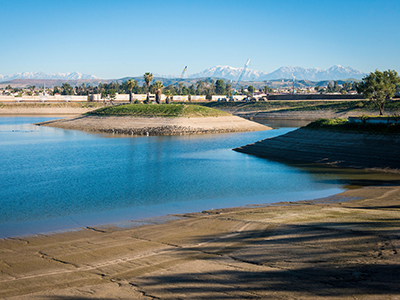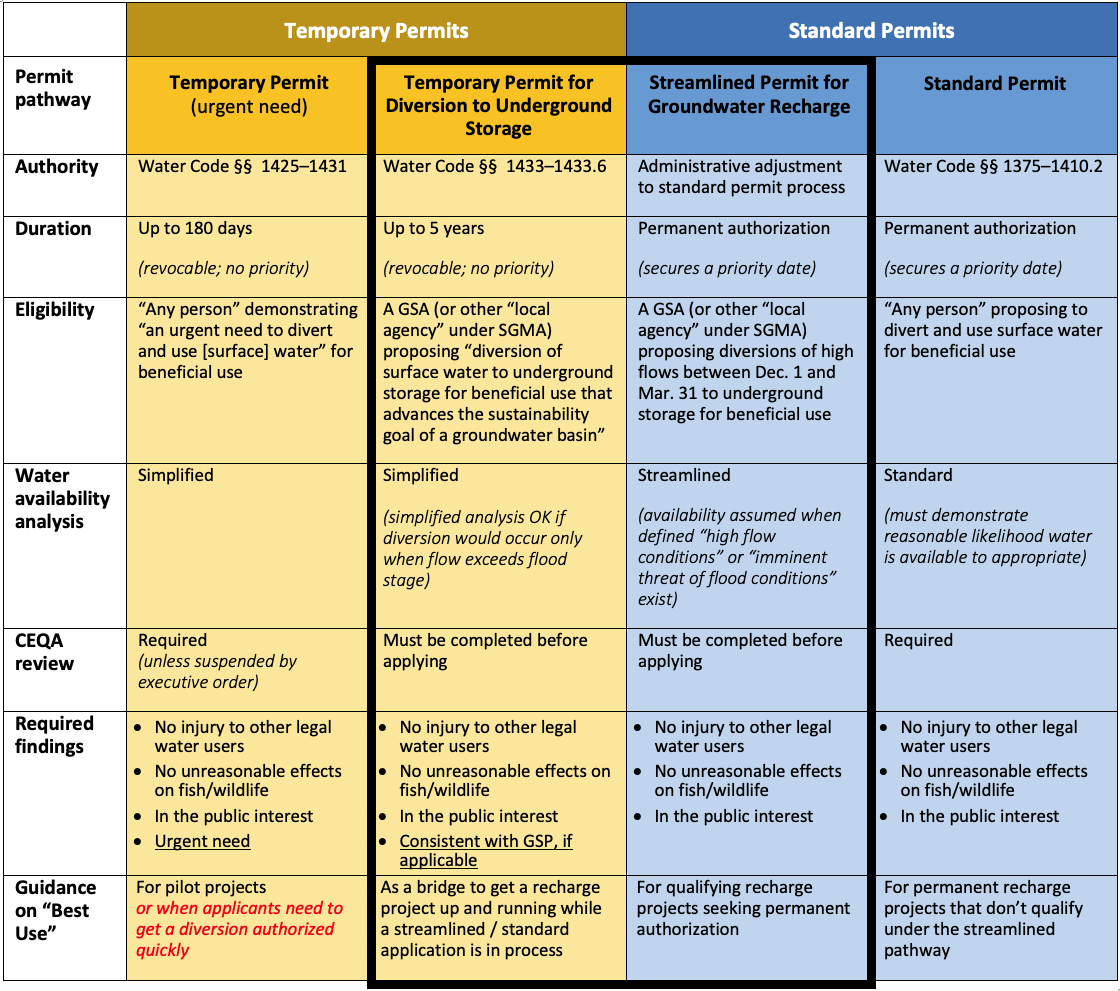

Efforts to boost groundwater recharge are critical to making California’s limited, and increasingly volatile, water resources go further. Recharge is playing a growing role in maintaining groundwater as an effective drought reserve and in slowing or reversing the effects of years of unsustainable groundwater pumping. But implementing recharge projects is not easy. Water managers face a range of hurdles. Even with the Sustainable Groundwater Management Act (SGMA) on the books, and the increasing availability of technical assistance, local decision makers are left mostly to their own ingenuity to figure out how to shore up groundwater resources to meet future needs. Many Groundwater Sustainability Agencies (GSAs) expect recharge to help them meet their responsibilities under SGMA. But the details of how they will implement recharge projects are often unclear.
One practical barrier is securing a source of water and the legal right to use it. The state recently added two new water right permitting options specifically designed to make implementing recharge projects under SGMA more straightforward. Yet questions linger. Before the state rolled out the new options, some recent recharge projects relied on temporary permits, a potentially uncomfortable match for long-term projects. The new temporary permit option appears to better suit recharge projects, but some of the state’s guidance on when it is appropriate to use each of the available permit types raises questions about how they fit into the overall water rights scheme. This matters because water rights administration is the primary tool the state has to ensure that surface water diversions don’t exceed what is legally and hydrologically available (and, therefore, don’t cause harm to other water users and uses). The state’s permitting decisions affect water availability for all.
Below, we summarize the two traditional and two new water right permitting options, state guidance on when recharge project proponents should consider applying for each, and why—without further clarification—that guidance could have unintended consequences.
Traditional permit options
California’s permitting system for surface water rights went into effect at the end of 1914. Since then, acquiring a new surface water right has generally involved applying for a standard permit from the agency known today as the State Water Resources Control Board (Water Board). Standard permits are permanent authorizations to divert and use surface water on a first-in-time, first-in-right basis. Acquiring one can take several years.
Beginning in the 1970s, the Water Board has also offered a temporary permit option to support a short-term “urgent need” to divert and use water. A temporary permit explicitly does “not result in the creation of a vested right, even of a temporary nature,” but can be modified or revoked at any time. Despite a nebulous statutory definition that leaves lots of room for interpretation [see Note 1, below], until 2016, the Water Board only approved temporary permits for projects that presented a clear narrative case for “urgent need” (see this typical permit). These permits served one-off special needs with a clear end date, such as stress testing a gas pipeline, enabling farmers to maintain their farms during active water rights litigation, addressing short-term water supply disruptions related to drought, or responding to an instance of contamination.
In the aftermath of the recent severe statewide drought, the reasons applicants sought temporary permits changed. Suddenly, every temporary permit was for a recharge project, where previously, none had been. The drought focused attention on the need for sustainable groundwater management, and on recharge as one important tool for achieving it. The state supported this shift by enacting SGMA, as well as through various executive actions.
Using a traditional temporary permit for recharge might make sense on an ad hoc basis when there is a good case for an urgent (and short-term) need. Picture trying to harness temporary high flows during a storm in the midst of severe drought to replenish dwindling groundwater reserves. Or rerouting some would-be flood flows from a river system that’s full to bursting during an unusually wet period following that severe drought and infiltrating them for later use.
But a traditional temporary permit probably isn’t a good fit for the types of recharge projects GSAs and other groundwater managers will be undertaking to meet their responsibilities under SGMA. Why? These are not one-off special needs with a clear end date, but projects GSAs hope to operate on a long-term basis, even if recharge occurs at irregular intervals (such as where the water source is legally and hydrologically available for project use only sporadically).
New permit options for recharge projects under SGMA
Recognizing the importance of ramping up recharge efforts to meet SGMA’s goals, the state recently rolled out two new permit options. These options are specifically intended to expedite water right permitting for recharge projects by GSAs and other local agencies working to implement SGMA.
Late last year, the State Legislature created a new class of temporary permit for diversion to underground storage “for beneficial use that advances the sustainability goal of a groundwater basin.” These last longer than a traditional temporary permit (5 years, instead of 180 days) and lack the “urgent need” requirement. These features respond to the poor fit of traditional temporary permits for ongoing recharge projects. (Like the traditional temporary permit, the new 5-year temporary permit can be modified or revoked and does “not result in the creation of a vested right, even of a temporary nature.”)
Around the same time, the Water Board adopted an administrative initiative to streamline the process for obtaining a permanent water right for a recharge project under SGMA, resulting in a streamlined permit for groundwater recharge.

How should GSAs use the available permitting options?
Now that the state has doubled the potential permitting options for recharge projects, when should GSAs consider using each one? In particular, under what circumstances would a traditional temporary permit make sense?
In a webinar late last year, Water Board staff offered guidance on the “best use” of each the four permitting options for groundwater recharge projects. A detailed summary of the webinar is available on the widely read California water website, Maven’s Notebook. With respect to the two temporary permit options, Water Board staff suggested the following:
- The new temporary permit option can serve as a bridge to help GSAs get a recharge project up and running while applying for a permanent water right.
- A traditional temporary permit can be used for a pilot recharge project or “when applicants need to get a diversion authorized quickly.”
There may indeed be some situations in which a traditional temporary permit for a recharge project under SGMA would be consistent with historical precedent. For example: a pilot project where the goal is to take advantage of high flows that might become available in the near-term to test out whether a particular recharge method or location is workable before investing in developing a full-scale, longer-term project.
But the last bit of guidance, emphasized in italics above, raises more questions than it answers. Aside from a pilot project, why would a GSA need to get a diversion authorized so quickly for a project meant to help it meet its responsibilities under SGMA? Expediency, alone, is not one of the rationales historically used to support an urgent need.
Without further explanation, this guidance might unintentionally encourage GSAs to apply for traditional temporary permits in situations where a temporary permit for diversion to underground storage (coupled with an application for a permanent water right that secures a diversion priority date) would be more appropriate. GSAs could get stuck in a cycle of applying, over and over again, for a series of traditional temporary permits to support a long-term project in order to avoid going through the more time-consuming and expensive process of securing a permanent water right. But that could work to their eventual detriment if, in the meantime, others secure permanent rights to use the water they have come to depend on. It would also result in shallower, less thorough analysis of the year-round and longer-term impacts of the project, which could obscure the extent of its potential effects on other water users and environmental flows (also a potential concern with the new 5-year temporary permit option).
These concerns aren’t just hypothetical: there are multiple examples of nearly identical serial temporary permit applications being submitted between 2016 and 2019, before the new permitting options were available.
Avoiding unintended consequences
The Water Board and the Legislature deserve credit for working to develop water right permitting options that address the unique needs of local groundwater managers in this new era of SGMA implementation: a new streamlined permit pathway GSAs can use to secure a permanent water right with a specific priority date, and a new 5-year temporary permit that can serve as a bridge while applying for a permanent water right. These new tools seem better suited to the types of recharge projects local groundwater managers are likely to pursue to help them meet their obligations under SGMA.
While it might be tempting for recharge project proponents to seek a traditional temporary permit—the quickest path to getting water in the ground—in most cases, a different permitting option will be more appropriate. Serial use of traditional temporary permits could short-circuit critical water right protections for the project itself, for other water users, and for water-dependent ecosystems, chipping away at the integrity of the overall water rights system and, ultimately, the sustainability of California’s water supplies.
Thankfully, the Water Board is in the midst of updating its website to more fully reflect the new permitting options and, critically, differences between the two types of temporary permits. We hope it further clarifies when each permit option is an appropriate vehicle for groundwater recharge (for example, through a Fact Sheet and updated Frequently Asked Questions) and diligently evaluates each permit application it receives to ensure that other water users and uses are protected, drawing on available information and tools to assess the project’s potential impacts.
[Note 1]: “Urgent need” is defined as “the existence of circumstances from which the board may in its judgment conclude that the proposed temporary diversion and use is necessary to further the constitutional policy that the water resources of the state be put to beneficial use to the fullest extent of which they are capable and that waste of water be prevented; except that the board shall not find an applicant’s need to be urgent if the board in its judgment concludes, if applicable, that the applicant has not exercised due diligence either (1) in making application for a permit pursuant to provisions of this division other than this chapter, or (2) in pursuing that application to permit.” Cal. Water Code § 1425(c).
The post Water right permitting options for groundwater recharge: Avoiding unintended consequences appeared first on Legal Planet.
By: Nell Green Nylen
Title: Water right permitting options for groundwater recharge: Avoiding unintended consequences
Sourced From: legal-planet.org/2020/07/27/water-right-permitting-options-for-groundwater-recharge-avoiding-unintended-consequences/
Published Date: Mon, 27 Jul 2020 22:47:10 +0000
Vist Maida on Social Me
Website Links
Maida Law Firm - Auto Accident Attorneys of Houston, by fuseology

No comments:
Post a Comment